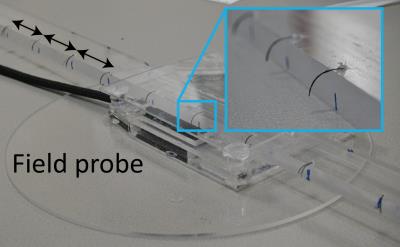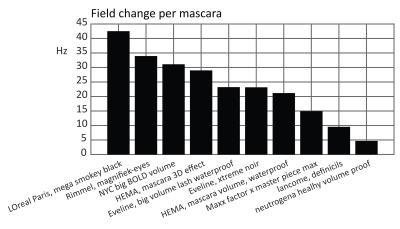5222
Cost-effectiveness analysis of mascara for eye-blink detection in ultra-high field MRI1Radiology, Leiden University Medical Center, Leiden, Netherlands, 2Ophthalmology, Leiden University Medical Center, Leiden, Netherlands
Synopsis
Mascara has been proposed as a simple approach to correct for eye-motion artefacts via detection of induced B0 changes when blinking. In this study we measure the B0 changes from 10 different types of mascara. We can differentiate three different categories of mascara, in which in violation of Murphy’s law the cheapest brands result in the strongest B0 field changes.
Purpose
MR eye imaging in combination with field probe based eye blink detection has been shown as a method to detect and correct for eye motion related artifacts in ocular MRI (1). The sensitivity of eye blink detection, however, needed to be improved for clinical integration. The field probe eye blink signal was increased by up to a factor of 10 when mascara was applied to the eyelashes. Mascara has, due to its metallic particles a high magnetic susceptibility. The large B0 change from the mascara results in the desired higher blink detection sensitivity. The aim of the current study was to determine the optimal mascara to detect eye blinks, taking into account the cost of the investigational device.Methods
An array of fake eye lashes was constructed to simulate eye blinks in a reproducible manner, see Figure 1. A trained lab-assistant (JW) applied the mascara of 10 different brands to the eye lashes, one eye lash was not coated as a reference.
All measurements were performed on a 7 Tesla MR scanner (Philips Achieva, Best, The Netherlands), using a commercially available field probe system (Skope Magnetic Resonance Technologies LLC, Zurich, Switzerland). The array was moved over the field probe to simulate subsequent blinks with the different mascara brands. The field probes measured the field deviations every 20 ms. The experiment was performed three times by two independent operators. The measured field change over time is shown in Figure 2a, the B0 offset due to the magnetic susceptibility of the acrylic bar was removed by low order fitting, Figure 2b, followed by automatic peak detection in Matlab (Mathworks).
Results
The field changes caused by the simulated eye blinks could easily be detected in the field probe measurements. The fake eye lash without mascara did not produce a measurable field change. There was a significant variation in the field change for the different mascara brands, ranging from 4 Hz for “Neutrogena Healthy volume proof”, to 43 Hz for “L’Oreal Paris, mega smokey black”, as summarized in Figure 3.Discussion
The prices of the different types of mascara varied greatly, from £0.5/ml to almost £3.5/ml. A visual cluster analysis of the field change versus price, revealed three different types of mascara, see Figure 4. The first type contains the relatively expensive mascara brands, which result in a low B0 change, that can be attributed to a lack of metallic compounds. The second type contains the relatively cheap mascara brands which cause a strong magnetic field change. This type of mascara contains metallic particles including Iron Oxides, Chromium Oxide, Chromium Hydroxide, Titanium Dioxide. The third type consists of the organic mascara brands, which produce the lowest field changes. For robust eye-blink detection, a high field change is desirable, making the first type of mascara not only the most effective category, but also the most economically viable one.Acknowledgements
No acknowledgement found.References
1. Wezel J, Garpebring A, Webb AG, van Osch MJP, Beenakker J-WM. Automated eye blink detection and correction method for clinical MR eye imaging. Magn. Reson. Med. 2016:n/a-n/a. doi: 10.1002/mrm.26355.Figures



